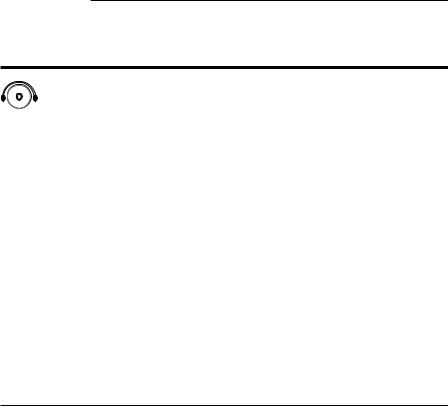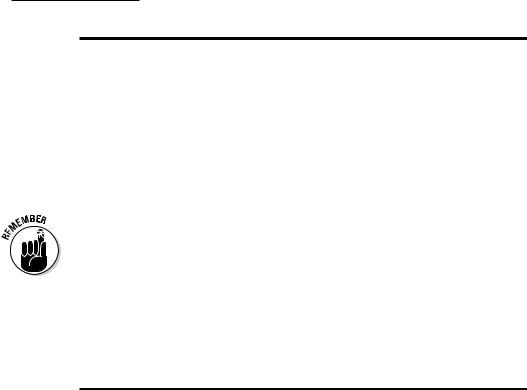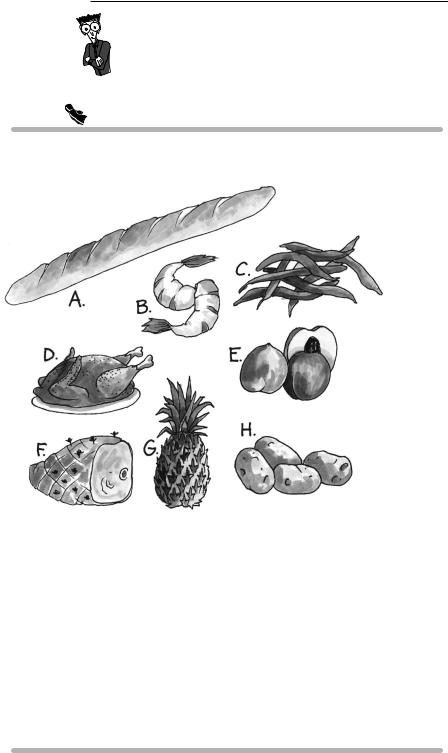
- •About the Authors
- •Dedication
- •Acknowledgments
- •Table of Contents
- •Introduction
- •About This Book
- •Conventions Used in This Book
- •Foolish Assumptions
- •How This Book Is Organized
- •Icons Used in This Book
- •Where to Go from Here
- •The French You’re Familiar With
- •Idioms and Popular Expressions
- •Key Parts of Speech
- •Cavorting with Verbs
- •Forming Sentences and Questions
- •The French Alphabet
- •Uttering Vowel and Consonant Sounds
- •Greetings: Formal and Friendly
- •Asking Questions to Get to Know People
- •Counting Your Lucky Stars: Numbers
- •Using the Calendar and Dates
- •Telling Time in French
- •Discussing Where You Live with the Verb “Habiter”
- •Discussing Daily Routine with Reflexive Verbs
- •Using Possessive Adjectives to Introduce Your Family Members
- •Basic Questions and Polite Expressions
- •Stating Your Preferences
- •Talking about Your Livelihood
- •Chatting about the Weather
- •Deciding to Keep in Touch
- •Getting Direction about Directions
- •Dining Out
- •Going to the Market
- •Going Shopping
- •Going Out with the Verb “Sortir”
- •Having Fun with the Verb “S’amuser”
- •Oh, the Places You’ll Go!
- •Making Plans with Friends
- •Making a Phone Call
- •Livin’ in the Past: Using the Past Tense
- •Playing Sports and Games
- •Going to the Beach
- •Setting Up Camp
- •Enjoying Quieter Pursuits
- •Where Do You Want to Go?
- •Getting Ready for Your Trip
- •Getting Current with Currency
- •Going to the Bank
- •Using Credit Cards and ATMs
- •Getting through the Airport
- •Navigating Buses, Trains, and Subways
- •Getting Around by Car
- •Finding Accommodations
- •Checking In to a Hotel
- •Checking Out of a Hotel
- •Getting Help Fast
- •Getting Medical Help
- •Handling Legal Matters
- •Label the Things in Your House
- •Write Your Shopping Lists in French
- •Listen to French Music
- •Watch French Movies
- •Tune in to TV5
- •Read French Publications
- •Take a Class
- •Join a French Association
- •Join an Online Chat or Pen Pal Forum
- •Using “Tu” When You Mean “Vous”
- •Using “Bonne nuit!” for Good-Bye
- •Using “Garçon” or “Porteur” to Address Service Staff
- •Saying “Je suis excité(e)” to Indicate Excitement
- •Saying “Je suis chaud(e)/froid(e)” to Say You’re Hot or Cold
- •Saying “Je suis plein/e” to Mean You’re Full
- •Using “de la glace” to Request Ice
- •Using “Je suis . . . ans” to Tell Your Age
- •Asking for Change with “J’ai besoin de change”
- •Using the Verb “Visiter” in Reference to People
- •“À mon avis”
- •“C’est pas vrai”
- •“Avec plaisir”
- •“C’est génial”
- •“À votre santé”
- •“À vos souhaits”
- •“Quelle horreur!”
- •“À bientôt”
- •“Passez-moi un coup de fil!”
- •“On y va!” or “Allons-y!”
- •“Je n’en sais rien”
- •“Je n’en reviens pas”
- •“Ça vaut la peine”
- •“C’est pas grave”
- •“N’importe”
- •“Tu cherches midi à 14h”
- •“Prenons un pot!”
- •Regular French Verbs
- •Auxiliary French Verbs
- •Track Listing
- •Customer Care
- •Index

130 Part II: French in Action
Talkin’ the Talk
Julie and Mike are thoroughly enjoying their meal and relaxing when the waiter comes along. (Track 8)
Le serveur: Vous voulez un dessert? vooh vooh-ley uhN deh-sehr?
Would you like dessert?
Julie: Non, merci. Deux cafés seulement et l’addition. nohN, mehr-see. duh kah-fey suhl-mahN ey lah-dee-syohN.
No, thank you, just two coffees and the check.
The waiter comes back with the check, and Mike takes out his credit card.
Mike: Vous prenez les cartes de crédit? vooh pruh-ney ley kahrt duh krey-dee?
Do you take credit cards?
Le serveur: Bien sûr, monsieur. byaN sewr, muh-syuh.
Of course, sir.
Finding the restrooms
Before leaving the restaurant, you may want to visit the restroom, in which case you ask Où sont les toilettes, s’il vous plaît? (ooh sohN ley twah-leht, seel vooh pleh?) (Where are the restrooms?). In French restaurants, the restrooms are usually located en bas (ahN bah) (downstairs). Don’t forget to take some change along with you; you often have to pay to get in! In most places, the pictogram is self-explanatory, but you may also see Dames (dahm) (women) or Hommes (ohhm) (men) written on the door.
Going to the Market
Outdoor markets are a delight. They’re especially nice in small, country villages, where you can enjoy the local fare and delight in the noises, smells, and accents. But big cities have wonderful markets, too. Certain Paris districts have a market most days of the week in the morning, rain or shine.
www.ATIBOOK.ir

Chapter 8: Bon Appétit! Dining Out and Going to the Market 131
Montréal is famous for its outdoor all-day markets during the summer months. The largest places and many small town squares also have les halles (ley ahl) (an indoor market). What better way to try out your French? After all, you can point to what you want and maybe learn the right word from
a friendly vendor. Vendors in an outdoor market sell almost everything. In many of them, you can even find clothes, shoes, kitchen utensils, and, of course, flowers.
Making purchases with the verbs “acheter” and “vendre”
It is just too tempting to go to le marché (luh mahr-shey) (outdoor market) and not buy anything. These markets are great places to buy the freshest and most deliciously ripe fruit for your next snack, or some cheese and bread for your picnic. Whatever your purchases, you make them with the use of the verbs acheter (ahsh-tey) (to buy), and venders sell items with the verb vendre (vahN-druh) (to sell). Vendre is a regular –re verb (check out Chapter 2 for the conjugation of regular verbs) and acheter is a stem changing verb just like the verb préférer (prey-fey-rey) (to prefer), discussed in Chapter 6. Here are the conjugations of vendre and acheter.
Conjugation |
Pronunciation |
je vends |
zhuh vahN |
tu vends |
tew vahN |
il/elle/on vend |
eel/ehl/ohN vahN |
nous vendons |
nooh vahN-dohN |
vous vendez |
vooh vahN-dey |
ils/elles vendent |
eel/ehl vahNd |
Conjugation |
Pronunciation |
j’achète |
zhah-sheht |
tu achètes |
tew ah-sheht |
il/elle/on achète |
eel/ehl/ohN ah-sheht |
nous achetons |
nooh-zah-shtohN |
vous achetez |
vooh-zah-shtey |
ils/elles achètent |
eel-/ehl-zah-sheht |
www.ATIBOOK.ir

132 Part II: French in Action
Often, you use acheter in its infinitive form. For example, you may say Je voudrais acheter des cerises (zhuh vooh-dreh-zahsh-tey dey suh-reez) (I would like to buy some cherries). With so much variety at the fruit stands, you don’t have to limit yourself. Here is a list of fruits (frwee) (fruit) you may find at le marché (for a list of meats, seafood, and vegetables available at these markets, refer to the lists in the earlier section “Perusing the menu”):
la pomme (lah pohhm) (apple)
la banane (lah bah-nahn) (banana)
la poire (lah pwahr) (pear)
la pêche (lah pehsh) (peach)
l’abricot (m) (lah-bree-koh) (apricot)
la cerise (lah suh-reez) (cherry)
la figue (lah feeg) (fig)
le raisin (luh reh-zaN) (grape)
l’ananas (m) (lah-nah-nah) (pineapple)
la prune (lah prewn) (plum)
la framboise (lah frahN-bwahz) (raspberry)
l’orange (f.) (lohr-ahNzh) (orange)
la fraise (lah frehz) (strawberry)
la pastèque (lah pahs-tehk) (watermelon)
Of course, you can’t have only one grape or one raspberry, right? To make any of these fruit plural, just make the articles plural (les) (ley) (the) or ask for some by using the indefinite article des (dey) (some): for example, Je voudrais des abricots (zhuh vooh-dreh deyz-ah-bree-koh) (I would like some apricots). Also check out the following section on the metric system to buy a specific quantity.
Specifying how much you want
The metric system was adapted by the French in the 18th century and is used in the majority of countries around the world. If you travel to France or to any other country for that matter, being familiar with the metric system is very handy, especially when you want to buy something scrumptious at
the market.
The basic metric unit of weight is the gram, and you usually buy fruit, vegetables, or meat in multiples of the basic gram. Table 8-1 lists the values for the gram.
www.ATIBOOK.ir

Chapter 8: Bon Appétit! Dining Out and Going to the Market 133
Table 8-1 |
Measuring Amounts in Grams |
|
|
French |
Pronunciation |
Translation |
Conversion |
|
|
|
|
un gramme |
uhN grahm |
1 gram (g) |
1 lb. = 453.60 (g) |
|
|
|
|
un kilogramme/ |
uhN kee-loh- |
1 kilogram (kg) |
1kg = 1000 g, |
un kilo |
grahm/uhN kee-loh |
|
about 2.2 lbs. |
|
|
|
|
un demi-kilo/une |
uhN duh-mee-kee- |
half a |
1⁄2 kg = 500 g, = |
livre |
loh/ewn lee-vruh |
kilogram/a |
about 1.1 lb. |
|
|
pound |
|
If you want a pound of cherries, for example, make sure you ask for une livre de cerises (ewn lee-vruh duh suh-reez) (a pound of cherries) because if you ask for un kilo de cerises (uhN kee-loh duh suh-reez), you’ll definitely get much more than you can eat!
Metric units are also important when you’re traveling, especially when you have to determine distances (meters) or fill up your gas tank (liters). For information on the metric conversions for those units, head to Chapter 15.
Talkin’ the Talk
Friday morning is le jour du marché (luh zhoohr dew mahr-shey) (market day). Madame Arnaud takes her nephew Thibaud along with her to go shopping at the local outdoor market.
Mme |
Thibaud, qu’est-ce que tu aimes comme fruits? |
Arnaud: |
tee-boh, kehs-kuh tew ehm kohhm frwee? |
|
Thibaud, what kind of fruit do you like? |
Thibaud: |
Tous! Mais à cette saison, je préfère les pêches. |
|
toohs! meh ah seht seh-zohN, zhuh prey-fehr ley |
|
pehsh. |
|
All of them, but at this time of year, I prefer peaches. |
Madame Arnaud and Thibaud wait in line at the fruit stand. When their turn comes, Madame Arnaud addresses le vendeur (luh vahNduhr) (the vendor).
www.ATIBOOK.ir

134 Part II: French in Action
Mme |
Donnez-moi un kilo de pêches, s’il vous plaît. |
Arnaud: |
dohh-ney-mwah uhN kee-loh duh pehsh, seel |
|
vooh pleh. |
|
Give me 1 kilogram (2.2 pounds) of peaches, please. |
Le vendeur: |
Voilà madame, et avec ça? |
|
vwah-lah mah-dahm, ey ah-vehk sah? |
|
Here you are, ma’am, anything else? |
Mme |
Je voudrais aussi un demi-kilo d’abricots et un |
Arnaud: |
demi-kilo de raisins. |
|
zhuh vooh-dreh oh-see uhN duh-mee kee-loh dah- |
|
bree-koh ey uhN duh-mee kee-loh duh reh-zaN. |
|
I would also like a pound of apricots and a pound |
|
of grapes. |
Le vendeur: |
Très bien madame. C’est tout? |
|
treh byaN mah-dahm. seh tooh? |
|
Very well, ma’am. Would that be all? |
Mme |
C’est tout merci. Ça fait combien? |
Arnaud: |
seh tooh mehr-see. sah feh kohN-byaN? |
|
That’s all, thank you. How much is it? |
Le vendeur: |
Huit euros. |
|
weet-uh-roh. |
|
Eight euros. |
|
|
Words to Know
tous |
toohs |
all of them |
mais |
meh |
but |
donnez-moi |
dohh-ney-mwah |
give me |
Voilà |
vwah-lah |
There you go |
Et avec ça? |
ey ah-vehk sah |
Anything else? |
|
|
And with that? |
C’est tout |
seh tooh |
That’s all |
Ça fait combien? |
sah feh kohN-byaN |
How much is it? |
www.ATIBOOK.ir

Chapter 8: Bon Appétit! Dining Out and Going to the Market 135
Shopping at neighborhood food shops
When you don’t have time to go to the outdoor market, or you can’t find what you need at the little store, the supermarket comes in handy. France has some huge supermarkets that line the highways as you enter a city. Some of them are so large that they are called hypermarchés (ee-pehr-mahr-shey) (hypermarkets) instead of supermarchés (sew-pehr-mahr-shey) (supermarkets). Here, you can find absolutely everything: food, clothes, computers, large appliances, and sometimes even cars! They’re certainly convenient, but if you visit France and have some time on your hands, go discover the little neighborhood food stores. You’re sure to enjoy them.
Because supermarkets are often rather far from the inner city, the French do their daily shopping in the neighborhood stores. They can buy their bread, meat, and vegetables daily because the stores are so conveniently close
to each other. Following are some of les petits magasins (ley puh-tee mah- gah-zaN) (the little [food] stores) that you would find in most neighborhoods throughout France:
la boulangerie (lah booh-lahN-zhree) (the bakery). La boulangerie sells bread and bread products, like des croissants (dey krwah-sahN) (croissants), and du pain aux raisins (dew paN oh reh-zaN) (raisin bread).
la pâtisserie (lah pah-tees-ree) (the confectioner’s shop). These shops specialize in cakes and pastries, usually of a higher quality. They don’t sell bread.
la boucherie (lah booh-shree) (the butcher shop). Here you can find fresh cuts of all sorts of meats like beef, veal, lamb, goat, and chicken.
la charcuterie (lah shahr-kew-tree) (deli, butcher shop). These shops specialize in pork and prepared foods.
la poissonnerie (lah pwah-sohn-ree) (the fish store).
l’épicerie (f) (ley-pees-ree) (the grocery store). L’épicerie is more like a general store.
la crèmerie (lah krehm-ree) (the dairy shop). This is where you can buy dairy products and cheese.
le marchand de fruits et légumes (luh mahr-shahN duh frwee ey ley-gewm) (the produce vendor). These stores have all kinds of fresh vegetables.
A fairly large number of people — mostly older — still go shopping for food every morning in France. They walk from store to store buying everything they need for the day’s meals. It’s also not unusual for the French, especially in big cities, to buy bread twice a day. French bread is made without preservatives and doesn’t keep well, so buying in small quantities more often makes better sense. Plus, French bread tastes so good when it’s freshly baked!
www.ATIBOOK.ir

136 Part II: French in Action
 Fun & Games
Fun & Games
Identify the items illustrated in each of the following pictures.
A.____________________
B.____________________
C.____________________
D.____________________
E.____________________
F.____________________
G.____________________
H.____________________
www.ATIBOOK.ir
